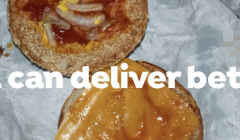
Knorr spotlights fast food fails to deliver better
The campaign from MullenLowe highlights that home made food can be better than takeaways.

Charlie Terry explores the benefits and nuances of crowdfunding a brand

I’ve been known to enjoy a beer or two in my time and, thanks to the work I do, I also keep a close eye on new ventures in the D2C space. So you won’t be surprised to hear that not long ago I gave a decent sum of money to a low alcohol beer start-up via a crowdfunding platform. And I’m pleased to say I’ve been rewarded ever since by watching a great business succeed, to produce more of the drink I like, with the added bonus of discounts and other fermented goodies along the way.
And I’m not alone, there are many more beer enthusiasts happily crowdfunding my favourite brewery - in fact, there are people all over the world who are so passionate about all sorts of things that they happily invest in them with no desire for monetary return - rather they want to be a part of something.
Beers. Technology. Games. Clothes. Food. Apps. Fintech. You name it, people want to fund it. Indeed, in Europe, where crowdfunding grew as people sought to keep business dreams alive during the pandemic, some platforms such as Crowdcube are seeing up to 16,000 individuals pledge £11m+ for some ventures.
Meanwhile, the European online “alternative finance” market - essentially crowdfunding in all its various guises - tripled between 2015 and 2018, according to The Crowdfunding Hub. At the start of the pandemic, there were also more than 630 crowdfunding platforms operating in Europe, contributing to a total volume of €6.5 billion in what is now a firmly established (and recently regulated) market.
Today, that market continues to grow and evolve, with crowdfunders usually either making altruistic donations, or investing in return for equity or rewards. From a psychological point of view, this presents a unique opportunity for marketers to tap into an audience who are already committed enough to a brand’s success that they have parted with cash out of goodwill alone. Aside from charity, in what other walk of life does anyone merrily pay something for nothing in return?
If someone is funding a fledgling brand, then it is clearly in their interests to see it flourish
Charlie Terry, Founder and Managing Director of CEEK
And it is the characteristics of this crowdfunding audience that are so striking from a digital marketing perspective. These are, by and large, ardent supporters of what they are prepared to financially back - yet the marketing application surrounding them is not fully understood, nor realised. It’s time to change that, and begin formalising the strategies to make it work harder.
If someone is funding a fledgling brand, then it is clearly in their interests to see it flourish. This makes them a natural advocate and long-term supporter of the business, and thus their marketing potential is significant.
Indeed, by linking marketing with the rewards crowdfunders usually receive for their investment, a business can build a community of motivated brand advocates delivering word-of-mouth, micro-influence and social media reach - all of which ultimately amplify the ability of a business to grow, and move crowdfunding beyond the realm of just finance.
It’s an approach that should obey a few rules, however.
To begin with, it’s essential to isolate and treat the crowdfunding community very differently to any other customer audience. They are not the same and need ring-fencing and treating with particular care, bespoke content and messaging.
And if a business is looking to grow its crowdfunding audience, and would like the secondary benefit of the marketing it can help support, it should find them on the platform that the product or service is to be marketed. This might seem unimportant or inconsequential to some, but there is nuance in such consistency.
It’s also important to have brand guidelines in place before utilising crowdfunders for any form of marketing advocacy; a business is relinquishing some degree of control, so having consistent and clear branding will help ensure advocates are on message, using the right channels and working to a defined schedule. This will also help track, and measure the advocacy marketing.
Additionally, there should always be a ‘what if?’ plan for what to do with the money. Crowdfunding can be a fickle game - and a business should have a predefined strategy in place should funding be significantly lower or higher than projected, because both outcomes are regular occurrences.
This also feeds into the essential trust and transparency businesses must foster with their communities at all times. For obvious reasons, no one can afford disgruntled brand advocates.
Finally, if a business is using a third-party crowdfunding platform, it should learn how to play the algorithms before committing to the marketing plan. Many platforms will pay much closer attention to anything they notice generating buzz, so it pays to go in with a well timed strategy to capitalise on any previous groundwork from a first round of funding or social media and community building efforts.
This is new ground for marketing, but in many ways it is simply an evolution of loyalty card schemes. However, instead of just rewarding someone for buying more, they are being invited to become part of a brand’s journey and an active member of its community.
That is a very potent and largely untapped marketing opportunity. It’s time to approach it with a clearer mindset and a set of measurable goals - and make it a community that truly rewards both the customer and the brand over the long term.
Charlie Terry is Founder and Managing Director of CEEK, the digital marketing consultancy
Looks like you need to create a Creativebrief account to perform this action.
Create account Sign inLooks like you need to create a Creativebrief account to perform this action.
Create account Sign in